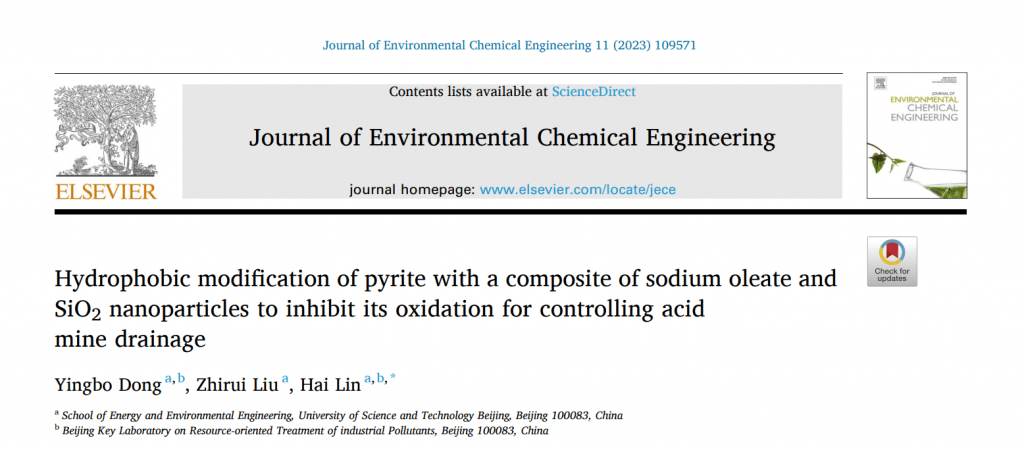
Author:Zhirui Liu, Master's degree student
Instructor:Prof. Yingbo Dong
Correspondence unit:School of Energy and Environmental Engineering, University of Science and Technology Beijing
DOI:https://doi.org/10.1016/j.jece.2023.109571
✦Results Profile✦
Recently, Zhirui Liu, a master's student in the group, published a paper entitled "Hydrophobic modification of pyrite with a composite of sodium oleate and SiO with a composite of sodium oleate and SiO2 nanoparticles to inhibit its oxidation for controlling acid mine drainage 》. This study used sodium oleate and silica nanoparticles to form a novel composite material for hydrophobic modification of pyrite to form a hydrophobic passivation film on the surface of pyrite, thus inhibiting its oxidation for controlling acid mine drainage from the source. The study evaluated the antioxidant performance of the hydrophobic passivation film on the surface of pyrite using chemical leaching and electrochemical tests, and further investigated the mechanism of hydrophobic modification of pyrite by the composite material.
✦ Abstract✦
The formation of acid mine wastewater (AMD) is mainly due to the oxidation of pyrite in water. In this study, environmentally friendly sodium oleate (SO) was used as a hydrophobic agent with the addition of SiO2Nanoparticles were used as fillers for the modification of pyrite. Sodium oleate and nano-SiO2The nanoparticles formed hydrophobic passivation films directly on the pyrite surface in a very simple process. At a reaction temperature of 70°C, the addition of 6% of SO and 1wt% of SiO2Excellent antioxidant capacity can be obtained. Chemical leaching experiments and electrochemical experiments were used to characterize the antioxidant effect of this hydrophobic passivated film. The results showed that the pH of the leach solution could be maintained above 5.7, which increased by 2.6 compared to the untreated pyrite. in addition, the SO42-and total Fe concentration can be reduced up to more than 83.69% and 97.91%, respectively. Compared with the original pyrite, the SO-SiO2The treated pyrite showed a lower oxidation rate in electrochemistry and an increase in contact angle of 70.1◦ . Finally, in this paper, scanning electron microscopy (SEM), Fourier transform infrared spectroscopy (FTIR) and X-ray photoelectron spectroscopy (XPS) analyses were used to elaborate the SO-SiO2The mechanism of action on the surface of pyrite. The results show that sodium oleate can combine with iron ions to form iron oleate wrapped on the surface of pyrite, while silica nanoparticles attach to pyrite by physical adsorption, filling the pores on the surface of hydrophobic film layer and effectively protecting pyrite from oxidation.
✦ Author✦

Zhirui Liu, a master's student of environmental engineering in University of Science and Technology Beijing, Class of 2020, whose research interests are the preparation of modified hydrophobic materials and their inhibition of acid production from waste rock oxidation. He has participated in projects such as the investigation of risk sources of drinking water sources in Beijing and the investigation of environmental conditions of groundwater in Dongying Chemical Park.
This research was funded by the National Key Research and Development Program of China (2019YFC1805002) and the National Natural Science Foundation of China (51874018), with special thanks! Finally, congratulations again to the master's student, Zhirui Liu, and wish the graduate students in the subject group to keep innovating, make further efforts, achieve fruitful results, and run to a bright future.
Source: Environmental Biotechnology and Environmental Materials Development Team Public

